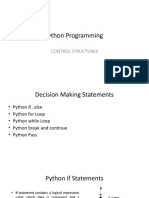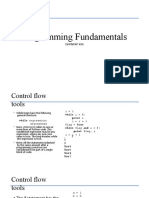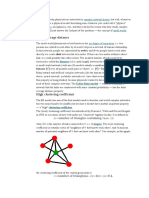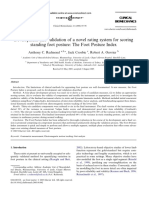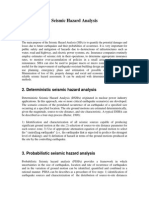COMPUTER SCIENCE- XI BY SUMIT GARG SIR
Ch- 9 Flow of Control
Flow of Control refers to the order in which statements are executed in a program.
Sequential Flow
The default control flow in a program is sequential flow, in which statements are executed line-by-
line one after the other in a sequence in which they are written.
Example
x=6
y=7
z=y-x
print(z)
Conditional Flow
Conditional flow refers to execution of certain statements only if a specific condition is met. This
is accomplished by the use of conditional statements such as if, if-else, and if-elif-else.
Example
num = int(input("Enter a number : "))
if(num>5):
print("Number is greater than 5")
else:
print("Number is less than 5")
Output
Enter a number : 55
Number is greater than 5
Iterative Flow
Iteration means 'repetition'.
Iterative flow repeats statements in a block of code. Repetition or looping can be performed a fixed
number of times or until a certain condition is met. This is accomplished through the use of
iterative statements: for and while.
Example-1
name = input("Enter your name : ")
for x in range(5): # range function creates a sequence of integers from 0 to 4
print("Hello", name)
1
COMPUTER SCIENCE- XI BY SUMIT GARG SIR
Example-2
name = input("Enter your name : ")
i=1
while i<=5:
print("Hello", name)
i +=1
Conditional Statements
Conditional statements execute specific blocks of code based on certain conditions. In Python,
conditional statements are implemented using the keywords if, if-else, and if-elif-else.
Terminology
Indentation
Indentation refers to the spaces at the beginning of a line.
Example
if a<5:
print(a)
print('Inner Block')
print('Outside block')
Block of code
A block of code is a set of statements that are grouped together and executed as a single unit. A
block of code is identified by the indentation of the lines of code.
if statement
The if statement is used to execute a block of
code only if a certain condition is true.
Syntax:
if <condition>:
Set of Statements
Flow Chart of if-statement
2
COMPUTER SCIENCE- XI BY SUMIT GARG SIR
Example-
age = int(input("Enter your age : "))
if age>=18:
print('Congratulations')
print('You are allowed to vote')
Program
Write a python Program to find the absolute value of the number entered by the user.
num = int(input("Enter any number : "))
if num>=0:
abs_num = num
else:
abs_num= - num
print(abs_num)
Output
Enter any number : -5
5
Program
Write a python Program to sort three numbers entered by a user.
a = float(input("Enter the first number : "))
b = float(input("Enter the second number : "))
c = float(input("Enter the third number : "))
if a > b:
a, b = b, a
if a > c:
a, c = c, a
if b > c:
b, c = c, b
print (a, "<", b, "<", c)
Output
Enter the first number : 30
Enter the second number : 25
Enter the third number : 20
20.0 < 25.0 < 30.0
3
COMPUTER SCIENCE- XI BY SUMIT GARG SIR
if-else statement
The if-else statement is used to execute one block of code if a certain condition is true, and another
block of code if the condition is false.
Syntax of if-else
if <condition>:
set of statements
else:
set of statements
Example
age = int(input("Enter your age : "))
if age>=18:
print('Congratulations')
print('You are allowed to vote')
else:
print('You are not allowed to vote')
print('Thanks')
Flowchart of if-else statement
4
COMPUTER SCIENCE- XI BY SUMIT GARG SIR
Program
Write a python Program to check if a number entered by a user is divisible by 3.
num=int(input("Enter a number : "))
if num % 3 == 0:
print(num,"is divisible by 3")
else:
print(num,"is not divisible by 3")
Output
Enter a number : 601
601 is not divisible by 3
if-elif-else statement
if-elif-else statement is used to check multiple conditions.
Program
per = int(input("Enter Percentage : "))
if per >= 75:
print("Distinction")
elif per >= 60:
print("Grade-A")
elif per >= 50:
print("Grade-B")
elif per >= 40:
print("Grade-C")
else:
print("Grade-D")
5
COMPUTER SCIENCE- XI BY SUMIT GARG SIR
Flowchart of if-elif-else statement
Iterative Statement
Iterative statements execute a set of instructions multiple times. 'for' and 'while' loops are the
iterative statements in Python.
while Loop
The while loop repeatedly executes a block of code as long as the specified condition is true.
The while loop is an exit controlled loop, i.e. the user is responsible for exiting the loop by changing
the value of the condition to False. While loop may run infinitely if the condition remains true.
Syntax:
while (condition):
block of statements
Flowchart of while loop
6
COMPUTER SCIENCE- XI BY SUMIT GARG SIR
Example
Write a Python Program (using a while loop) to Find the Sum of First 10
Natural Numbers.
num=1
sum=0
while (num <= 10):
sum = sum + num
num = num+1
print ("Sum of Natural Numbers : ", sum)
Example
Write a Python Program (using the while loop) to Find the Sum of First N Natural Numbers
where N is entered by the user. num=1 sum=0
n = int(input("Enter the value of n : ")) while (num <=
n):
sum = sum + num
num = num+1
print ("Sum of Natural Numbers : ", sum)
range( ) Function
range( ) is a built-in function that returns a sequence of numbers.
Syntax:
range(start, stop, step)
start: The starting value of the sequence (inclusive). If not specified, it defaults to 0.
stop: The ending value of the sequence (exclusive).
step: The difference between two consecutive elements. Its default value is 1.
The range( ) function can be used in for loops to iterate over a sequence of
numbers.
Case-1 x = Case-2 Case-3 Case-4
list(range(5)) x= x = list(range(3,20,2)) x = list(range(0, -9, -1))
print(x) list(range(3,6)) print(x) print(x)
Output print(x) Output Output Output
[0, 1, 2, 3, 4] [3, 4, 5] [3, 5, 7, 9, 11, 13, 15, [0, -1, -2, -3, -4, -5, -6, -7,
17, 19] 8]
for Loop
The for loop is used to iterate over a sequence (such as a list, tuple, string, etc.) and execute a block
of code for each item in the sequence.
7
COMPUTER SCIENCE- XI BY SUMIT GARG SIR
Syntax for <control_variable> in
<sequence>:
Block of code
Flowchart of for loop
Example-1 Example-2
list1 = [1,2,3,4,5,6,7,8,9,10] str1 = 'India'
for var1 in list1: for each_character in str1:
print(var1) print(each_character)
Program-1
Write a Python Program (using for loop) to Find the Sum of First 10 Natural Numbers.
sum=0
for num in range(1,11):
sum = sum + num
print ("Sum of Natural Numbers : ", sum)
Output:
Sum of Natural Numbers : 55
Program-2
8
COMPUTER SCIENCE- XI BY SUMIT GARG SIR
Write a Python Program (using for loop) to Find the Sum of First N Natural Numbers where N is entered
by the user.
sum=0
n = int(input("Enter the value of n : "))
for num in range(1, n+1):
sum = sum + num
print ("Sum of Natural Numbers up to : ",n, “is”, sum)
Output:
Enter the value of n : 20
Sum of Natural Numbers up to 20 is : 210
Program-3
Write a Python Program (using for loop) to find the factorial of a number.
num = int(input("Enter a number: "))
factorial = 1
if num < 0:
print("Sorry, factorial does not exist for negative numbers")
else:
for i in range(1, num + 1):
factorial *= i
print("The factorial of", num, "is", factorial)
Output
Enter a number: 5
The factorial of 5 is 120
Break and Continue Statement
Break Statement: The break statement is used to terminate a loop immediately. It is typically used
with conditional statements.
Continue Statement: The continue statement skips all the remaining statements in the current
iteration of the loop and moves the control to the beginning of the next iteration.
Example :
fruits = ['apple', 'banana', 'cherry']
for x in fruits:
if x == 'banana':
break
print(x)
Example :
9
COMPUTER SCIENCE- XI BY SUMIT GARG SIR
Write a program in Python to check if a number entered by a user is a prime number or
not.
num = int(input("Enter a number: "))
flag=False
if num > 1:
for i in range(2, num):
if (num % i) == 0:
flag=True
break
if flag==True:
print(num, "is not a prime number")
else:
print(num, "is a prime number")
Example :
Write a program in Python to print all natural numbers from 1 to 10
except 7.
for i in range(1,11):
if i==7:
continue
print(i)
Example :
Write a program in Python to print all natural numbers between 1 and 50 (both inclusive) which
are not multiple of 3.
for x in range(1, 51):
if x % 3 ==0 :
continue
print(x)
Nested loops
Nested loops refers to a loop within a loop.
Example: Generating a pattern
n = int(input("Enter the number of rows: "))
for i in range(n):
for j in range(i+1):
print("*", end="")
print()
Output
Enter the number of rows: 5
*
10
COMPUTER SCIENCE- XI BY SUMIT GARG SIR
**
***
****
*****
11








